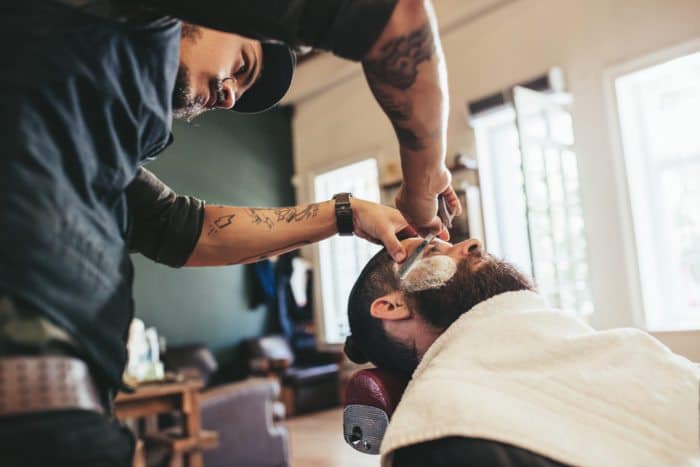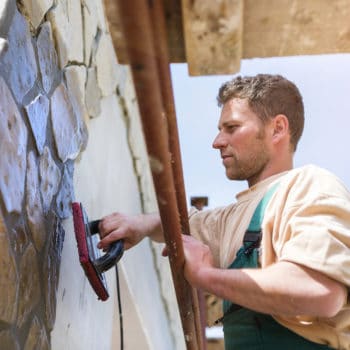Why We Love It
-
$29,140Potential Avg. Salary
-
10%Job Growth Rate
-
Growing DemandJob Outlook
-
Don't Take Work HomeCareer Attribute
Barbers cut hair, trim and shape beards, and fit hairpieces. They most commonly work in barbershops where only male clients are serviced. Some barbers also own their own barbershops and are responsible for scheduling appointments, managing business paperwork, and marketing their services.
Recommended Schools
What is a Barber?
The following job responsibilities are common for individuals in barber roles:
- Discuss hairstyles with male clients and cut hair into desired styles
- Perform facial shaving services, including both clean shaves and moustache/beard shaping
- Make clients feel comfortable by engaging in small talk, encouraging both tips and repeat visits
- Schedule appointments, recruit new clients, and take payments for services
- Less commonly: apply hair color, set permanents, or fit clients for hair pieces
A Day in the Life
Barbers are stylists who focus their talents on male clientele. They work in barbershops, performing hair cutting, shaving, and beard-trimming services. Barbers may work in one of three types of situations: they may be employed full-time by a barber shop owner, they may rent a booth in a barber shop, or they may own their own barber shop. Barbers who rent booths or own their own shops must recruit new clientele, while those who work for established shops may have more walk-in clients.
When clients arrive for appointments, barbers consult with clients as to what type of hairstyle they’re looking for. This may be as simple as a trim, or it may require flipping through pages of books or images on the internet to find the client’s preferred cut. Then, the barber washes and cuts the client’s hair to match the selected style. The barber may also shave the client’s face—if desired—or may trim and shape client’s facial hair. When finished, the barber dries and styles the client’s hair.
Barbers may also be in charge of scheduling client appointments and taking payments for services. One important role of the barber is also to make the client feel comfortable; the more comfortable the client feels, the more likely the barber will be to earn a tip, and the more likely the client will be to return. Talented, charismatic barbers have the potential to earn above-average hourly wages from service fees and tips, and satisfied clients are likely to return to the same barber for years or decades in the future.
Typical Work Schedule
Barbers generally work hours during first and second shifts, and they commonly work on weekends when people are off work. Barbers who own their own shops are able to set their own schedules and work whenever they want. Both part-time and full-time schedules are common in this profession.
Projected Job Growth
Due to population growth leading to more people who need routine haircuts, it’s expected that demand for barbers will grow in the coming decade.
Typical Employers
Most barbers work for either barbershops or salons. Many are also self-employed and operate their own barbershops or rent booth space in a barbershop owned by someone else.
Recommended Schools
How To Become a Barber
All states require barbers to become licensed in order to practice in the state. To become licensed, aspiring barbers must attend a postsecondary school that specializes in barbering. Similar to cosmetology school, barbering schools are vocational institutions that teach students how to cut, color, and style hair, how to perform facials, how to properly care for different hair types, and how to shape facial hair into different styles. After graduating from a barbering school, students earn the proper state licensure and can begin working as barbers in their state of residence.
Generally, barbers start out working as employees of established barbershops or salons. This allows new barbers to gain professional experience and begin building a clientele base. After working in an established barbershop for several years and acquiring many clients, barbers commonly move into self-employment. Renting a booth at a barbershop or owning a barbershop allows barbers to make more money, though it also makes them fully responsible for running a business.
Because attracting clientele and managing a business requires savvy marketing and business skills, many barbers find it beneficial to take coursework in business and marketing at the college level. Associate’s degrees in marketing or business can teach aspiring self-employed barbers how to market their services, manage their business finances, and maintain business paperwork for tax and legal purposes.
Barber Salary Data
We’ve provided you the following to learn more about this career. The salary and growth data on this page comes from recently published Bureau of Labor Statistics data while the recommendations and editorial content are based on our research.
National Anual Salary
Low Range
$19,830Average
$29,140High Range
$47,410National Hourly Wage
Low Range
$10/hrAverage
$14/hrHigh Range
$23/hrHow do Barber salaries stack up to other jobs across the country? Based on the latest jobs data nationwide, Barber's can make an average annual salary of $29,140, or $14 per hour. This makes it an Above Average Salary. On the lower end, they can make $19,830 or $10 per hour, perhaps when just starting out or based on the state you live in.
Salary Rankings And Facts
#715 Nationally for All Careers
Highest Education Among Barbers
- 0.1% Doctorate
- 0.3% Masters
- 4.2% Bachelors
- 7.2% Associates
- 26.8% College
- 48.7% High School
- 12.8% Less than High School
Job Growth Projections and Forecast
2014 Total Jobs
59,2002024 Est. Jobs
65,100Job Growth Rate
10%Est. New Jobs
5,900How does Barber job growth stack up to other jobs across the country? By 2024, there will be a change of 5,900 jobs for a total of 65,100 people employed in the career nationwide. This is a 10% change in growth over the next ten years, giving the career a growth rate nationwide of Below Average.
Growth Rankings And Facts
#198 Nationally for All Careers
What Companies Employ The Most Barbers
| Industry | Current Jobs | New Jobs Needed | % Increase |
|---|---|---|---|
| Self-employed workers | 45,000 | 4,500 | 5% |
| Personal care services | 13,400 | 1,400 | 1% |
| State government, excluding education and hospitals | 100 | --- | --- |













